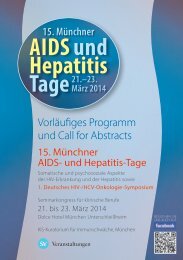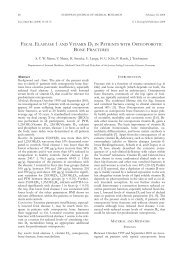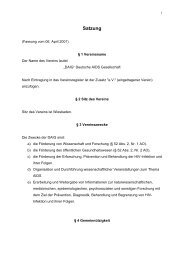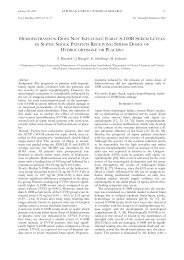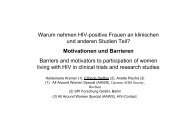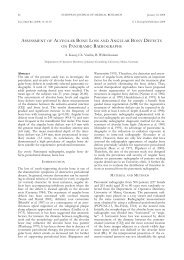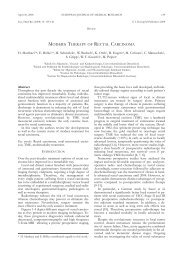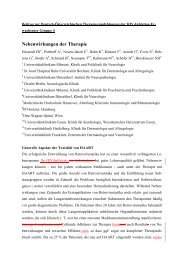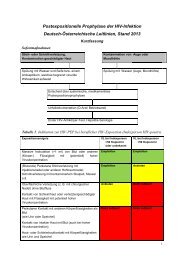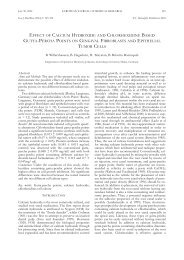European Journal of Medical Research - Deutsche AIDS ...
European Journal of Medical Research - Deutsche AIDS ...
European Journal of Medical Research - Deutsche AIDS ...
You also want an ePaper? Increase the reach of your titles
YUMPU automatically turns print PDFs into web optimized ePapers that Google loves.
June 27, 2007 EUROPEAN JOURNAL OF MEDICAL RESEARCH<br />
59<br />
und einer antiretroviralen Behandlung zugeführt (non-<strong>AIDS</strong><br />
und <strong>AIDS</strong> Patienten ohne/mit Therapie). Neuropsychologische<br />
Tests und eine Lumbalpunktion wurden durchgeführt und<br />
Zytokinspiegel im Liquor mit einem speziellen Antikörper-<br />
Chip bestimmt.<br />
Ergebnisse: Alle Patienten unterschieden sich nicht hinsichtlich<br />
ihres Alters und der CD4-Zellzahl. Die Viruslast war<br />
bei allen behandelten Patienten im Blut und Liquor nicht<br />
nachweisbar. Unbehandelte Frühstadienpatienten zeigten<br />
schlechte Testergebnisse im Digit-Symbol-Test, dem Trail-<br />
Making-Test und der Feinmotorikanalyse bei hohen Liquorspiegeln<br />
von IL-4, IL-5 and GRO; behandelte Frühstadienpatienten<br />
hatten bei hohen Spiegeln von pro-inflammatorischen<br />
Zytokinen signifikant schlechtere Ergebnisse in der HIV-Demenz<br />
Skala. Behandelte <strong>AIDS</strong> Patienten zeigen dagegen bei<br />
hohen Spiegeln von ALCAM (CD166), Fas (CD95) und IL-<br />
18 bessere Ergebnisse in der HIV-Demenz-Skala.<br />
Diskussion: Die Studie konnte einen schwachen Zusammenhang<br />
zwischen entzündlichen Reaktionen und neuropsychologischen<br />
Defiziten im Zentralnervensystem von HIV-Patienten<br />
mit oder ohne antiretrovirale Therapie feststellen. Interessant<br />
ist, dass es <strong>of</strong>fensichtlich einen frühzeitigen, direkt virusvermittelten<br />
Schaden bei hoher Virusreplikation gibt, der durch<br />
eine antiretrovirale Therapie nur unvollständig positive beeinflussbar<br />
ist. In späten Stadien ist eine Virusreplikation unterhalb<br />
der derzeitigen Nachweisbarkeitsgrenze in Zusammenhang<br />
mit einer autoimmunologischen Dysfunktion des Immunsystems<br />
als Mediator der fortschreitenden neuropsychologischen<br />
Defizite wahrscheinlich.<br />
B.18 (Vortrag)<br />
Impact <strong>of</strong> depression on overall and health related<br />
Quality <strong>of</strong> Life (QoL) in HIV- and cancer-patients<br />
Wulff W. 1 , K<strong>of</strong>ahl-Krause D. 2 , Stoll M. 1 , Schmidt R.E. 1<br />
1 <strong>Medical</strong> School Hanover, Clinical Immunology, Hannover,<br />
Germany, 2<strong>Medical</strong> School Hanover, Haematology,<br />
Haemostaseology and Oncology, Hannover, Germany<br />
Aims: The estimates for lifetime prevalence <strong>of</strong> depression in<br />
HIV patients differ between 22 and 45% compared to appr.<br />
15% in non HIV infected people (1). Also in cancer patients<br />
published prevalences <strong>of</strong> depression range between 1,5 and<br />
53% (2). The impact <strong>of</strong> depression on overall or health related<br />
QoL in these groups is very plausible but not well established.<br />
HIV- and cancer-Patients were assessed by different tools for<br />
QoL, depression and personality.<br />
Methods: 50 HIV- and 54 cancer-Patients were assessed for<br />
their overall QoL with the SEIQoL-DW interview (3) and the<br />
MLDL questionnaire (4) and for their health related QoL with<br />
the SF-36 questionnaire (5). Depression was assessed with the<br />
BDI questionnaire (6) and personality with the FPI-R inventory<br />
(7). Stepwise regression analyses were performed.<br />
Results: (See Table 1)<br />
Referring to the health related QoL depression is the first<br />
factor for both HIV and cancer patients in the subscale health<br />
perception explaining 40.6% <strong>of</strong> variance (HIV patients) and<br />
39.8% (cancer patients). In the category mental health depression<br />
is the first factor for the HIV group explaining 52.5% <strong>of</strong><br />
variance, but for the cancer group BDI-depression is only the<br />
second factor explaining 12.2% <strong>of</strong> variance behind the the<br />
first factor FPI-emotionality with 49.0%. The models for all<br />
other subscales do not include BDI-depression or show it only<br />
as the second or third factor explaining minor percentages <strong>of</strong><br />
variance.<br />
Conclusions: Depression substantially influences QoL in<br />
both HIV and cancer patients. The overall QoL seemed to be<br />
even more affected than health related QoL. Regarding their<br />
mental health HIV patients are more affected by depression<br />
than cancer patients.<br />
Remarks: 1 Himmelhoch et.al. 2005; 2 Trask 2004; 3 Boyle et.al.<br />
1993; 4 v.Steinbüchel et.al. 1993; 5 Bullinger, Kirchberger 1998;<br />
6 Hautzinger et.al. 1995; 7 Fahrenberg et.al. 2001<br />
B.19 (Poster)<br />
Management <strong>of</strong> a HIV-exposed pregnancy with<br />
twin-to-twin transfusion syndrome (TTTS)<br />
Kost B.P. 1 , Kästner R. 1 , Sovric M. 1 , Kainer F. 1 ,<br />
Gingelmaier A. 1<br />
1 I.UFK, LMU München, Frauenklinik-Innenstadt, München,<br />
Germany<br />
Objectives: Options and risks <strong>of</strong> an invasive intervention<br />
(laser photocoagulation) in twin-to-twin transfusion syndrome<br />
(TTTS) and HIV-infection in pregnancy.<br />
Method: A case report<br />
Results: HIV infection <strong>of</strong> a 27 year old III-para I-para with<br />
monozygotic, diamniotic twins was diagnosed external in the<br />
9th week <strong>of</strong> gestation. At that time no indication for antiretroviral<br />
treatment was seen (viral load 2600 cp/ml, CD4 510<br />
cells/�l). In the 19+2 week <strong>of</strong> gestation a pronounced TTTS<br />
with pathological color duplex sonography <strong>of</strong> the donor (195g)<br />
and the acceptor (326g) with a massive polyhydramnion was<br />
established. Concerning the wack prognosis the indication for a<br />
laser photocoagulation was set. To reduce the risk <strong>of</strong> a vertical<br />
HIV transmission a antiretroviral therapy with Kaletra and Tru-<br />
Table 1



